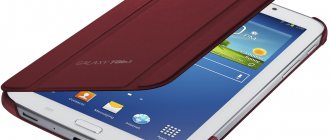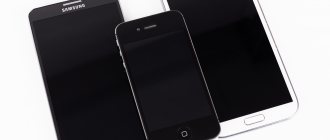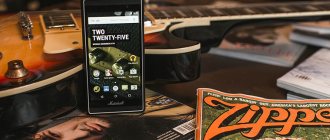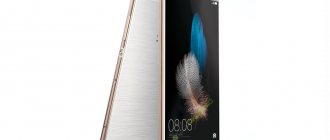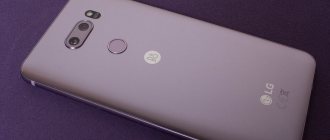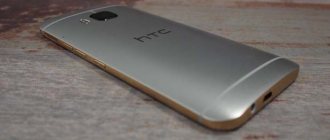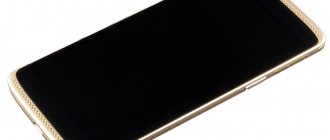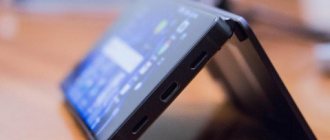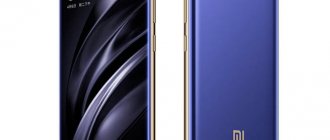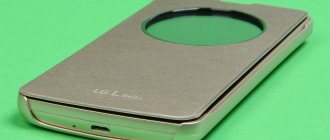Description of the HTC One M8 16GB smartphone
The Taiwanese company HTC evokes extremely positive emotions among its consumers.
The brand does not need aggressive advertising and does not chase flagships either in the speed of releasing new products or in introducing extra-new technologies; HTC smartphones are devices that combine reliability, excellent build quality and functionality that does not lose relevance for a long time. In 2014, the company introduced another new product - a smartphone balanced in every sense with an unconventional design - HTC One M8.
Appearance and equipment
The HTC M8, like the previous device in the One line, comes in a flat white box with an image of the smartphone itself, which has become a distinctive sign of the latest gadgets from HTC. On the packaging you can see a description of the main functions of the device, which are printed in a stylish gray-silver font and add attractiveness to the box. The case is made of monolithic aluminum with plastic inserts in the area where the slots and antennas are located, the device looks so stylish and reliable that there is no need to frame it with a case - you just don’t want to hide such a device in a faceless case.
The device was released in three discreet colors, each of which only adds solidity to the smartphone:
- Silver (silver);
- Gold (golden);
- Gray (gray).
The HTC M8 package includes:
- the device in one of three available colors;
- charging unit;
- USB-microUSB cable
- stereo headset with microphone and a set of replaceable earbuds;
- case in gray color, made of silicone;
- a paperclip for removing the card slot.
The HTC One M8, unlike its older brothers, has a smoother shape with rounded corners and, although it is larger than other models in the line, it feels more comfortable and pleasant in the hand.
The case is assembled by Unibody, in other words, the device has no removable parts, the only exceptions being a slot for a nano-sized SIM card and a memory card tray. The design is reliably protected from dust, does not creak or play during use.
The back cover of the device is decorated with strips of matte plastic that protect the two antennas of the device. At the top are the camera and flash windows, just below is the HTC logo, which stands out compared to the body not only in color, but also tactilely - the letters are “embossed” on the surface.
As already mentioned, the device is made in an aluminum case, but the top and bottom of the screen is framed by plastic with imitation metal; the same material is also used for the upper end of the device, where the power button and the infrared port are located, which makes it possible to control home appliances from a smartphone. It is worth noting that in earlier models of the line the power button was located on the left side of the top edge, however, given that the One M8 is taller than its peers, the manufacturers considered it correct to move the button to the right.
At the bottom of the device, as a logical conclusion to the screen, there is again the company logo, and just below, across the entire width of the case, there is a speaker with a built-in amplifier. Above the logo there are three touch control buttons: “Back”, “Home” and “Recent applications”. It is noteworthy that HTC rarely resort to using mechanical keys, leaving touch control as its distinctive feature.
The top of the front side has a speaker, in the grille of which proximity and light sensors are hidden, and on the right side of the top frame there is a peephole for a wide-format camera.
The weight of the device is 160 g, dimensions are 146.4 × 70.6 × 9.4 mm, these dimensions are quite suitable for carrying a smartphone in pockets, but navigation with one finger is difficult due to the height of the device, you need to get used to such dimensions.
HTC M8 screen
HTC One M8 received a Super LCD3 display, like most models in the line: with a screen diagonal of 5 inches, a resolution of 1920 × 1080 FullHD pixels and a pixel density of 441 ppi, you get a clear, bright picture with high contrast. The screen has wide viewing angles, the image does not fade at maximum tilt, color rendition is natural: while the colors are rich, the image does not fade into glowing neon.
Auto-adjustment is responsible for brightness that is comfortable for the eyes; in the One M8 it works very correctly and changes the screen parameters depending on the lighting so that the user is comfortable using the device.
The advantages of the M8 screen compared to many (including flagship) devices are the ability to control it with a stylus, excellent response to commands through gloves or even with wet hands.
Operating system and shell
The smartphone runs on the Android 4.4 KitKat operating system with the updated proprietary HTC Sense 6.0 shell. Visually, the new shell is practically no different from HTC Sense 5.0.
The first thing you notice when getting acquainted with HTC Sense 6.0 is the presence of virtual touch keys at the bottom of the screen. The icon design has not changed. In the notification panel, in its second tab, we added an icon for editing the location of shortcuts and their number. A total of 12 shortcuts can be displayed, and their total number is 24. Holding on any of them takes you to the corresponding menu. The icons in the settings menu, depending on whether the function is active or not, became gray-green. New items include “Print” and “Import from another phone” (Bluetooth is used to receive data).
The lock screen has not changed, but the lock icon can now be moved not only up, but also left and right. Depending on this, you will be taken to the main desktop window or BlinkFeed. In addition, you can go to Google Now from the lock screen. To enable widgets on the lock screen, you need to check the “Security” menu. Unlike other devices, you cannot launch the camera by swiping left; this gesture takes you to the menu with widgets.
The number of desktop windows has increased by one, to six. The leftmost window is reserved for the BlinkFeed news feed. You can delete it, but you cannot add a window with shortcuts and widgets in its place.
There is now a separate key to open the running applications manager (in the HTC One M7 you had to press the Home key twice). To delete an application, you need to swipe it up; to delete everything, press the cross at the top of the screen. Previously there was no such possibility. From here you can go to the running applications section.
The application list still allows you to change the number of icons displayed on one screen from a 3x4 matrix to a 4x5 matrix. Weather widgets were removed from the main screen, and the line with settings and sorting, on the contrary, was made non-deletable. The location of the shortcuts can be changed at your discretion, alphabetically or recently added.
Cameras
The M8 has a double camera, consisting of two windows designed to perform different functions:
- HTC UltraPixel with a resolution of 4 MP has a back-illuminated matrix, an f/2.0 aperture and a 28 mm lens;
- Collects information about the location of the object, focusing, and the ability to change parameters.
Duo Camera technology allows the owner of the device to customize camera parameters to suit specific needs, so in the menu you can find a huge number of additional functions, the most interesting of which is Ufocus, which determines the depth of the scene. Photos from the camera turn out clear, but it shoots objects best in macro mode, but text should be photographed in auto mode. The LED flash has several modes, in particular it can serve as a flashlight. The front camera allows you to take standard portrait photos with background blur.
Video shooting is available in a resolution of 1920×1080 pixels with a recording speed of 30 frames per second, additional features are slow motion and switching focus during the recording process.
Processor and system
The device is powered by a quad-core Qualcomm Snapdragon 801 processor with a frequency of 2.3 GHz and an Adreno 330 graphics accelerator. Such parameters allow the device to work quite quickly at medium graphics settings without losing speed. In some tests, there is a loss of sound, which is corrected by installing an additional player.
In the AnTuTu test, the smartphone received 33645 points - good results, considering the cost of the M8. Users compare the HTC device with the iPhone 5/5S, noting that the performance in medium-power games and when using applications for these gadgets is approximately at the same level.
HTC One M8 has 2 GB of RAM, but there are two options for internal memory - 16/32 GB. The volume can be expanded using a memory card, guaranteed support – up to 128 GB.
Results
After getting to know the HTC One closely, we were able to find out how much the new smartphone differs from its predecessor. The differences begin with the body, which received even more metal. Despite the increased dimensions and larger screen, the rounded sides and comfortable keys make the smartphone more ergonomic. The increased battery capacity is offset by the increased screen diagonal, so in terms of autonomy, the HTC One did not bring any surprises. Like most smartphones, with an average load the user can count on a day of work. But productivity has increased significantly. In this regard, HTC One (M8) has no competitors yet. The volume and sound quality leave no chance for opponents. If this parameter plays an important role for you, you simply cannot find a better smartphone. The virtually unchanged shell received a number of changes specific to the version of Android used. In addition, the new product has a slot for memory cards, gesture control and an additional camera. With the latter, not everything is so smooth. There are no complaints about its work, the same cannot be said about the resolution, but, again, not all smartphone users edit, let alone print, photos. Therefore, the vast majority of HTC One owners will be satisfied, especially since it makes no difference for a smartphone whether you shoot during the day or at night - in both cases you will be satisfied with the result.
Pros: build quality, case materials, sound, display, current OS version and updated HTC Sense 6.0 shell, hardware platform, memory card slot, IR transmitter, camera capabilities, gesture control, motion sensor, included headphones, special power saving mode , can be used with the HTC mini+ phone accessory
Cons: resolution of the main camera, noticeable heating of the case under load
Conclusion: a smartphone with an all-metal body, an excellent display, ample photography and video capabilities, excellent sound and a number of other pleasant features
Specifications
| HTC One (M8) 16GB Gunmetal Gray Notify when available | |
| Type | Smartphone |
| Pre-installed OS | Android 4.4.2 + HTC Sense, BlinkFeed |
| RAM, GB | 2 |
| Built-in memory, GB | 16 |
| Expansion slot | + |
| SIM card type | Nano-SIM |
| Number of SIM cards | 1 |
| CPU | Qualcomm Snapdragon 801 (MSM8974AB) + GPU Adreno 330 |
| Number of Cores | 4 |
| Frequency, GHz | 2,3 |
| Battery | Li-Pol, 2600 mAh |
| Diagonal, inches | 5 |
| Permission | 1920×1080 |
| Matrix type | Super LCD3 |
| PPI | 441 |
| Dimming sensor | + |
| Display Features | Protective glass Corning Gorilla Glass 3 |
| Main camera, MP | 4 |
| Video shooting | 1920x1080 pixels, 30 fps |
| Flash | double LED |
| Front camera, MP | 5 |
| Camera Features | Duo Camera: 1/3” HTC UltraPixel BSI sensor (2.0 µm pixel size), 28mm wide-angle lens with f/2.0 aperture, HTC ImageChip 2. HDR video (Full HD); second camera to determine the distance to the objects being photographed |
| Communication standards | GSM: 850/900/1800/1900;, WCDMA: 850/900/1900;/2100, LTE: 800/900/1800/2600 |
| WiFi | 802.11ac |
| Bluetooth | 4.0 (aptX) |
| GPS | + |
| IrDA | + |
| FM radio | — |
| Audio jack | + |
| NFC | + |
| Interface connector | micro-USB |
| Height, mm | 146,36 |
| Width, mm | 70,6 |
| Thickness, mm | 9,35 |
| Weight, g | 160 |
| Protection from dust and moisture | — |
| Type of shell | monoblock |
| Housing material | aluminum |
| Keyboard type | screen input |
| More | HTC BoomSound (dual front stereo speakers, powered by additional Sense Voice amplifiers) |
Networks and Communication
The dual-band Wi-Fi module can be configured to suit the user's needs or made as efficient as possible by disabling optimization. The smartphone can also work in router mode for 1-8 devices. The GPS module with Qualcomm IZat Gen8C chip is responsible for accurate location determination and cold start within 30 seconds. The built-in digital compass allows you to use the device as a full-fledged navigator.
The NFC system is available on the device, but it is only implemented by connecting to wireless accessories. Data transfer from device to device is ensured by Bluetooth 4.0 with A2DP support.
The entire One line has GPS/Glonass support with a cold start of 5-15 seconds. The devices come pre-installed with Google Maps and Google Navigation.
Display
The 5-inch screen is 0.3 inches larger than the original (HTC One), but it has the same resolution at 1920 x 1080 Full HD. While the pixel density is slightly lower at over 400 per inch, it gives the user really sharp images, sharp app icons and smooth text sharing that YouTube videos are easy as viewing angles are great - when combined with the superb Boomsound speakers they won't have hearing problems. The backlight keeps the screen really bright, in fact the display is so good that we can't see how HTC could have done any better. Battery life has been improved by raising power from 2,300mAh to 2,600mAh and including more than two power saving levels. The first one saves CPU usage, reduces screen brightness, stops vibration ringing and turns off communications and Mobile Internet when the display is locked. You can set a second, more extreme, level to activate should the battery level drop to 5, 10 or 20 percent. This means you can only use text, email, phone, calculator and calendar.
Battery
A 2600 mAh lithium-polymer battery and new energy saving methods announced by the company (including the use of a coprocessor) make the smartphone autonomous for 10 hours in test mode; in practice, it can be active for up to 23 hours with standard use of functions.
In energy saving mode, when vibration is turned off, brightness is reduced and data transfer is turned off, the device is able to add about 1.5 more hours to the main operating time.
A feature of the HTC One M8 that distinguishes it from other models in the line is the critical power saving mode; when activated, the processor goes into a reduced frequency mode, most sensors and sensors are inactive, but most importantly, only basic applications are available (calculator, calendar, mail, phone, messages), the rest are inactive, and this list cannot be changed. Considering that the HTC One M8 was presented to users in 2014, the device turned out to be extremely successful: the excellent combination of the recognizable style of HTC and the nimble “filling” made the smartphone popular and made it possible to draw the attention of buyers to the brand. Sales of the M8 device have become perhaps the highest among the company's products, which certainly indicates the success of the model.
Design and ergonomics
I'll start with design and ergonomics. The main feature of the original HTC One is the design and materials of the case. HTC has always strived to make devices recognizable and of high quality; there was a time when they stated that metal in the case was their calling card, they say, why spoil the experience of using the device? But it wasn’t possible to make something iconic, so we experimented with different materials, for example, the HTC One X was polycarbonate, the One S from the same line was methyl, processed using a special technical process, and so on. But only HTC One (M7) became so memorable and enjoyable. Everyone was talking about the smartphone and the model collected the most awards, including for design solutions, in 2013.
Naturally, once the right direction is grasped, one cannot abandon it. Following Apple's example, HTC is releasing the new HTC One (M8) in a very similar body, the main features of the two models are related. The body is not only similar to that of its predecessor, but also retains its main feature - it is made of aluminum. Moreover, the percentage of this same aluminum in the body increased from 70% to 90%.
It would be correct to say that HTC One compares favorably with many others in terms of design and materials; it seems to me that the smartphone will collect many awards this year as well. However, this design also has a flaw - the dimensions of the device. The new generation of HTC One has grown – 146.36 x 70.6 x 9.35 mm, versus 137 x 68 x 9.3 mm a year ago. Gained almost a centimeter in height! The weight has also increased – 160 g versus 143. This is not good, even taking into account the increased display diagonal from 4.7″ to 5″. The body has grown disproportionately; I would really like the smartphone to be more compact. Moreover, it seems to me that this could be achieved.
In its defense, the M8 has become more comfortable to hold thanks to its tapered edges, and the increase in size can partly be explained by improved stereo speakers, which accommodate larger sound chambers - 0.85 cm³ for the top speaker and 0.80 cm³ for the bottom one. The sound from them became 25% louder. There is also unconfirmed information that the smartphone was supposed to be protected according to the ip67 standard, but at the last moment they refused to mention the protection.
Perhaps due to the fact that the case was not as protected as in the Sony Xperia Z1/2 or SGS5, but there are already videos online showing the ability of the new HTC One to remain fully functional after a long stay under water. And it also requires a little space for protection. This, by the way, is what HTC One (M8) could be like (according to Theverge):
It was only necessary to abandon the huge frame under the display and slightly reduce the frame above it. Then we would get an almost ideal ratio between the size of the display and the body, and the new product would be more compact than the original model. But the HTC One (M8) is large, it almost reaches the size of the Samsung Galaxy Note 3, which has a 5.7″ display diagonal.
I'm glad that the lock key was moved from the left edge of the top edge to the right. I would like to see it on the right side of the smartphone, but this is better. Moreover, HTC has coolly implemented gesture controls, more on them later. Also pleasing is the presence of a slot for a Micro SD memory card, especially considering only 10 GB available to the user in the 16 GB version. Moreover, you don’t need to disassemble or turn off anything to change the memory card - convenient.
